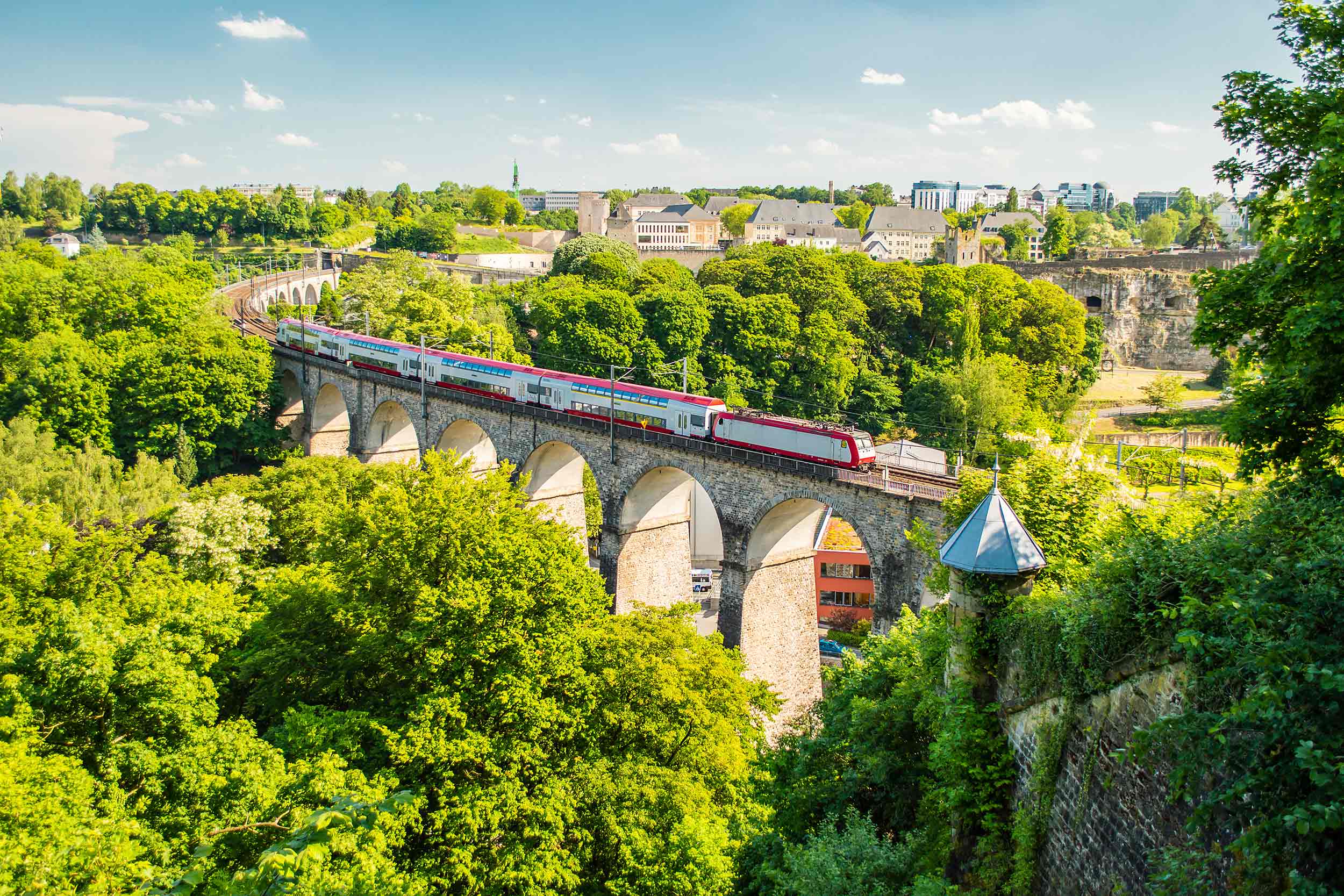Mobility: Adapt infrastructure to needs
For the DP, citizens should be able to get from A to B comfortably, reliably and quickly, whether by public transport, bicycle, car or a combination of different means of transport. For this to succeed, an attractive bus and rail service must be ensured throughout the country that is on a par with individual mobility.
In Luxembourg, there has been a huge backlog of transport infrastructure needs over the years, which only the DP-led governments have seriously addressed. Through the massive investments in the expansion of the train and tram network, the enlargement and redesign of many railway stations including the creation of additional parking areas, among others in Luxembourg City, Ettelbrück, Rodingen, Mersch and Wasserbillig, and the introduction of free public transport, the government has set an important course to offer people a real alternative to the car.
Nevertheless, major efforts are still needed to significantly reduce the time citizens spend in traffic jams every day. DP will consistently continue the investment offensive of the past years. The relevant transport infrastructures are to be developed in such a way that they anticipate the country’s future development and mobility needs. Instead of making up for past failures, the DP will launch forward-looking projects for the next 30 years today.
In doing so, the DP will take a holistic approach. In addition to a consistent decentralisation of workplaces and the promotion of teleworking and co-working spaces, the DP will expand existing railway lines and create new ones; expand the tram network, in particular implement a fast tram connection between the city of Luxembourg and Esch/Alzette as early as in the next few years; promptly realise a coherent network of safe cycle paths throughout the country; significantly expand parking facilities for commuters in the border region; and continue to invest in road infrastructure.
Whether bus, tram, train, car or bicycle, every means of transport has its function and its place in the eyes of the DP. The DP will ensure that citizens will continue to be free to choose the means of transport that best suits their needs and the way they want to get around. For example, DP will consider soft mobility and public transport connectivity in all major projects and promote multi-modality.
At the same time, the fluid linking of different means of transport will occupy a central place in the mobility of the future. The creation of so-called “Pôles d’échange” in Ettelbrück and Howald, among other places, takes this development into account and will be promoted in the future.
In recent years, the DP-led government has invested record sums in the expansion of public transport, in the rail and road network, and has thus been able to make up some of the historical backlog. However, much remains to be done in order to be able to offer citizens an optimal mobility offer. DP will address tomorrow’s problems today by immediately planning and implementing major mobility projects, such as additional rail and tram routes. We will continue to invest massively in the expansion of public transport, initiate major construction projects and ensure that they are realised as quickly as possible.
In addition to the planned budgetary resources, the DP will consider alternative financing models in cooperation with the European Investment Bank as well as private partners in order to mobilise the necessary funds for a proper investment offensive.
For DP, the railway is the means of transport of the future, whether in commuter traffic as an alternative to the car or in the area of goods transport. DP will continue to expand the rail network and increase capacity so that we can ensure an attractive and reliable rail transport service not only today, but also in the decades to come. Every line nationwide is to be upgraded to at least two tracks in order to improve frequency, punctuality and reliability and to increase the attractiveness of train services. Our goal is for citizens to have a connection to the capital every 10 minutes on the main lines in the medium term.
Specifically, the DP will initiate a complete double-tracking of the northern line over the next few years and also expand the section between Sandweiler-Contern and Oetringen to two tracks in order to dissolve this bottleneck. In this context, new stations are also to be planned on this section.
Furthermore, the DP will work to ensure that the direct connection between Ettelbruck, Diekirch and the capital operates at a significantly higher frequency and, if necessary, develop the necessary infrastructure to make this possible.
The DP will examine the construction of new train routes to guarantee a fast and regular connection, especially to the capital, but also to the conurbations in the respective regions, for example between Redingen/Attert and Ettelbrück. In addition, we will examine the use of parallel S-Bahn lines to the existing rail network in order to expand national connections towards the capital with the help of a closely timed, regional service. These S-Bahn lines are to run on a separate rail network in order to separate direct connections from so-called slow trains and to improve the reliability of all connections.
Rail transport will also play a central role in terms of intra-European and international travel in the coming years and will be crucial to Luxembourg’s attractiveness. It is therefore essential for DP to ensure good and fast connections to the most important major European cities in the region.
The DP will campaign for a fast connection to Brussels, Amsterdam, Cologne, Koblenz, Saarbrücken and Frankfurt. In particular, with regard to the connection between Luxembourg and Brussels, the DP will ensure that the two European capitals are linked by fast train. If necessary, the Luxembourg State shall co-finance a substantial part of this connection from its own resources.
The DP will also work to ensure that Luxembourg is optimally connected to the German rail network and that it is taken into account in all upcoming investments by the federal government in the rail network in the region. Here, too, the state should contribute financially, if necessary. The northern line is to be given a feeder function to the TGV trains in the Liège-Aachen area.
The DP will ensure that Luxembourg has an optimal connection to the long-distance networks of our three neighbouring countries. This connection also ensures that Luxembourg is well connected to the Europe-wide network of night trains.
Nevertheless, in the area of air transport, the DP will also advocate for more direct flights between Luxembourg and international economic centres. This is also a location factor.
The tram has more than proven itself as a means of public transport in urban areas. The DP is committed to a high-performance and comprehensive tram network in the urban area and will quickly implement the planned additional tram lines. These include the extension of the tram towards the airport, Cloche d’Or, Strassen, Hollerich, Merl and Zessingen. We will also review the planning of additional tram lines in the conurbations of the other regions, such as the Nordstadt communities.
The planned construction of a fast tram between Luxembourg City and Esch/Alzette should also be implemented as soon as possible. In addition, the DP will examine the extent to which further rapid tram connections, including on the N11 in the direction of Junglinster, make sense.
The DP will quickly implement the national network of cycle paths provided for in the law in its entirety. Currently, only about 700 km of the total planned almost 1,100 km have been completed. In order to move faster, the DP will create synergies with the affected municipalities and involve them in the implementation. In addition, the DP will introduce further support for the creation of municipal cycle paths and connections to national cycle routes. The realisation of municipal cycle paths should not be slowed down by excessively high state requirements, especially with regard to the required width. The DP will also create cycle lanes along the main axes, which will be reserved for bicycles and S-Pedelecs .
In this context, it is important for the DP that the cycle paths are clearly marked and well signposted, that they run separately from motorised traffic, have a surface that is easy to ride on and do not suddenly stop in the middle of nowhere. In this sense, the DP would also like to develop a digital platform, including an interactive cycling map with registered national and municipal cycling routes, cycling stations, tourist attractions and a “report-it” function.
S-Pedelecs should be allowed to use cycle paths up to a speed of less than 50km/h. However, narrow and at the same time busy cycle paths should be exempt from this regulation. To this end, as in Belgium, a separate category for S-Pedelecs is to be introduced in the Code de la route so that they are no longer equated with mopeds. In order to continue to guarantee the safety of all, driving licences, helmets, registration and insurance for S-Pedelecs should remain compulsory. However, only a normal bicycle helmet is to be prescribed as a helmet. Together with an extended network of cycle paths, this would make the use of bicycles more attractive.
The DP is committed to improving people’s quality of life by implementing concrete traffic calming measures within localities and will authorise municipalities to implement them on state roads as well. Instead of cars, which dominate the image of our villages and residential areas, public space should increasingly be reserved for people. In some places in the country, the implementation of a bypass is a prerequisite for calming through traffic, which is why the DP will implement it quickly and coherently. In other municipalities, on the other hand, it is already possible to give pedestrians and cyclists more space by intelligently dividing up public space. The DP will support the municipalities in implementing 30 km/h or 20 km/h zones, so-called “shared spaces”, where it makes sense and also approve them on state roads. New neighbourhoods should be planned from the outset with traffic calming measures and sufficient space for pedestrians and soft mobility.
Constant through traffic is a burden on the health and well-being of residents in many communities. The DP will consistently implement planned bypasses so that traffic-calming measures can be implemented in inner-city areas and the quality of life of residents can be improved. The DP will quickly implement projects for interconnected bypasses (as in Niederkerschen and Dippach) so that one of the communities does not suffer from traffic calming in the other.
The DP will create additional regional and border catchment parking areas that are well connected to public transport to encourage commuters more to switch to bus or train. The DP will introduce a mobile application for all interceptor parking areas nationwide, which will allow users to book a parking space for a limited time in advance, register their vehicle for quick and non-contact entry and exit, and pay any parking fees. For commuters who continue their journey by public transport or active mobility, parking in all reception parking areas is to be free of charge for 24 hours.
The DP will revise public transport timetables to better coordinate bus and rail services. In particular, the timetables and frequency of regional lines serving the stations need to be improved.
To make public road transport more attractive compared to private transport, the DP will create additional bus lanes in as many places as possible. Express bus lines in particular should be able to get their customers to their destination as quickly as possible, instead of them being stuck in traffic jams like all other vehicles.
In this context, the DP will also investigate at which locations bidirectional bus lanes can be installed. This model, where the bus travels in one direction in the morning and in the same lane in the other direction in the evening, can be implemented comparatively quickly in many places where a third lane already exists and relieve traffic.
With the reform of the RGTR network, bus transport over land was fundamentally reorganised during the last legislative period. In particular, the bus network was expanded nationwide, express bus lines and regional connections were introduced, and journey times were extended in the mornings, evenings and at weekends. The DP will subject the reform to a thorough examination and, if necessary, adapt it together with the municipalities and citizens.
The DP will conduct a comprehensive review of the specific public transport services, such as Adapto and Mobibus, and address the causes of the recurring problems. We will ensure that the respective services function reliably and get people to their destinations quickly and conveniently.
Refer to the chapter Digitisation and Media
The DP will ensure that passengers can move around unmolested on buses, trains and trams and that staff can go about their work in safety. For this reason, the DP will increase security staff.
In order to promote soft mobility more, the DP will provide bicycle parking, showers and lockers in all public buildings, such as schools and administrations. DP will also build more secured bicycle parking spaces (mBox) in sensible locations, such as near regional reception parking areas.
In addition, the DP, in cooperation with the municipalities, will set up a network of bicycle stations at busy locations, including air pumps, charging facilities for e-bikes, a car wash, repair equipment and spare parts.
Businesses bear a great responsibility for the mobility management of their employees. DP will support those businesses that implement mobility concepts for their employees. So-called “mobility managers” are to support businesses in the development and implementation of these concepts.
The DP wants to continue to encourage people to choose active forms of mobility. The existing state subsidies should therefore be continued and extended to cargo bikes.
The DP wants to use intelligent systems that can increase the number of lanes in one direction and decrease them in the other, depending on the traffic volume. Thus, more lanes could be made available in the morning in the direction of Luxembourg City and in the evening in the opposite direction. The DP will also explore the feasibility of a mobile guardrail system on our motorways and rural roads to increase capacity during rush hour. The DP will also explore the possibility of using the hard shoulders on the motorways as an additional lane during rush hours. In this way, the hard shoulder could be used as an additional lane in heavy traffic, as is already the case in some places abroad.
DP will deploy intelligent traffic information and traffic management systems on motorways and busy roads. This technology will increase road capacity through intelligent systems engineering and traffic management. In real time, such data on the load on the roads can be collected and linked with the data of the drivers in an intelligent traffic management. With the creation of an “Observatoire digital de la mobilité”, the foundation stone for modern, evidence-based mobility planning of the 21st century was laid in the last legislative period. The DP will further expand the collection of mobility-related data in order to be able to plan future transport projects in an even more targeted manner.
In addition, the DP will intelligently control the red traffic lights and also expand the green wave principle as much as possible.
In preparation for semi- to fully-autonomous driving, the DP will also push for the creation of smart infrastructure on key transport axes that will enable vehicle-to-infrastructure (V2I) communication.
The DP wants to expand the mobility app and centralise all relevant information and functions in one place so that users can find everything they need for their mobility in a single app. For example, bus and train times will be displayed in real time, including geolocation, and it will be possible to rent a bicycle or other vehicle, or to order and pay for a taxi. DP will therefore work with all stakeholders to unify their services on a single platform.
The DP will not only create the legal framework to allow partially or fully autonomous driving on our roads and rail network, but also invest in intelligent infrastructures that make this form of locomotion technically possible in the first place.
The DP will create a legal basis that allows the use of drones for various purposes beyond recreational use. A clear regulatory framework should make the use of drones quite simple, for example in rescue missions, for reconnaissance purposes or as a delivery service.
The DP will complete the planned reform of the taxi law and liberalise the market with the goal of reducing the high taxi prices. Thus, not only the different zones but also the upper limit for licences are to be abolished. The DP will also allow Uber and similar services in Luxembourg, on condition that drivers apply for a licence and are covered by labour law and social security. On the national mobility app, every driver should have the opportunity to offer their taxi services.
The DP continues to adhere to “Vision Zero”, i.e. the goal of zero deaths and zero serious injuries on our roads. The implementation of road construction measures, such as the defusing of dangerous stretches or the installation of traffic lights that switch to red when driving too fast on state roads, the sensitisation of road users and the use of radar devices, which can also detect the use of mobile phones at the wheel, are just some of the measures that the DP wants to implement.
However, special attention must be paid to the safety of pedestrians, cyclists and motorcyclists, as they are the weakest link in road traffic. Thus, creating a secure infrastructure for the DP is a top priority. In addition, we want to develop an overall concept that ensures the safety and visibility of pedestrians, especially in the cold season. This means, for example, even and effective lighting of zebra crossings and frequently used footpaths.
The DP is planning to introduce a new scheme that will allow car owners to customise their number plates as they wish for a fee, similar to what is already done in Belgium. However, this rule does not imply any acceptance or tolerance for breaches of the law, xenophobic behaviour or other inappropriate content.




